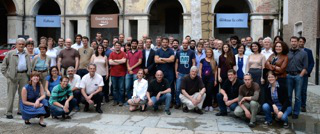Speaker
Esteban Curras
(CERN - IFCA(CSIC-UC))
Description
The high luminosity LHC (HL-LHC or Phase-II) is expected to increase the instantaneous luminosity of the LHC by a factor of about five, delivering about 250 fb−1 per year between 2025 and 2035. Under these conditions the performance degradation of detectors due to integrated radiation dose/fluence will need to be addressed. The CMS collaboration is planning to upgrade many components, including the forward calorimeters. The replacement for the existing endcap preshower, electromagnetic and hadronic calorimeters is called the High Granularity Calorimeter (HGCAL) and it will be realized as a sampling calorimeter, including 30 layers of silicon detectors totalling 600m^2. The sensors will be realized as pad detectors with cell sizes of between 0.5-1.0 cm^2 and an active thickness between 100 μm and 300 μm depending on their location in the endcaps: the thinner sensors will be used in the highest radiation environment. For an integrated luminosity of 3000 fb−1, the electromagnetic calorimetry will sustain integrated doses of 1.5 MGy (150 Mrads) and neutron fluences of 10x16 n/cm^2 in the worst case. A tolerance study after neutron irradiation of 300 μm, 200 μm and 100 μm n-on-p and p-on-n silicon pads irradiated to fluences up to 1.6x10 16 n/cm^2 is presented. The main properties of these diodes have been studied before and after irradiation: leakage current, capacitance, charge collection efficiency, annealing effects, timing capability. As expected, the results show a good performance even after the most extreme irradiation.
Primary author
Esteban Curras
(CERN - IFCA(CSIC-UC))

